Steven Mark Katzew is a Johannesburg-based advocate. He attended High School in Welkom, Orange Free State, going on to study Law at Rhodes University, Grahamstown. His articles on South African Jewish sporting personalities have appeared in Soul Sport and Jewish Affairs.
This is a story about a few good men passionate about the game of squash who, through using their own resources and endeavours, guided Johannesburg’s, and perhaps even South Africa’s, best known squash club, the Transvaal Automobile Club (known in squash circles as the TAC) to the official rating as South Africa’s Number 1 squash club. It is a story of vision, commitment, perseverance and patience. It is also a story with a strong Jewish flavour, for the TAC is, and remains, one of the adornments of Johannesburg Jewry - an institution that belongs to Johannesburg’s early beginnings through which the Jewish community was able to give full expression to its pursuit of the ultimate in excellence in the sporting field.
Perhaps fortuitously, the TAC was not, and never has been, an exclusively Jewish club. I say fortuitously because, as will be shown, wonderful non-Jewish players and a superb non-Jewish coach participated in the road to excellence. It is reflective rather of the enormous success of Johannesburg Jewry as a partner in the creation of this great city with a deep culture of institutionalised excellence.
The theme of commitment to excellence has a deeper significance too for the Jewish community. It is what keeps it flourishing and firmly committed to the excellence of its institutions that is so central to its acknowledged status as a flag-bearer for Diaspora Jewry on so many levels.
The story needs some contextualising and background.
The concept of a club as the crucible for sportsmen and sportswomen of a particular national or religious group is not uncommon. It is especially prevalent in the context of Diaspora communities of all persuasions. The reasons for their existence range from a natural tendency of members of a community to congregate in the same institutions to instances where members of a particular group establish their own clubs in response to being denied access to other clubs.
There are a number of examples in South Africa. Prominent amongst them was the erstwhile Jewish Guild in Johannesburg. Although constituted as a Jewish club, with the advent of professional soccer its soccer section attracted outsiders to the community. The result was that the soccer section of the club became a high profile open club with a Jewish ethos. The same applied to the soccer sections of the Greek clubs Hellenic in Cape Town and Corinthians in Johannesburg and to the Italian club Olympia, also in Johannesburg.
The focus of this article is the squash section of the famous TAC (in recent years renamed the Killarney Country Club, or KCC) which, although never constituted as a Jewish club, over time acquired a distinctively Jewish ethos due to the demographics of its surroundings. It nestles in the leafy suburb of Houghton adjacent to populous Killarney. It acquired its name, which is associated with motoring in the early 1900s, when the agricultural holding that once stood on the present site of the club, Cooks Farm, became the recognised rendezvous for burgeoning numbers of enthusiasts of the then nascent pastime of motoring. These informal gatherings of early motoring enthusiasts galvanised into an exclusive club of motoring patrons called the Transvaal Automobile Club, with its headquarters on Cooks Farm. The club evolved into the Automobile Association of South Africa (AASA), which ensured roadside assistance and safety to those early members. The appeal of an exclusive club devoted to motoring began to wane with the mass production of motor vehicles. The Transvaal Automobile Club, under the reconstituted guise of the AASA, relocated to premises closer to the Johannesburg commercial hub to become the ubiquitous dominant service provider of roadside assistance to motorists in South Africa. Cooks Farm, however, retained its status as a social club with its acquired name, the Transvaal Automobile Club.
With the gradual absorbing of the surrounding farmland into rapidly expanding suburban Johannesburg, the TAC became a popular retreat for residents of the neighbouring suburbs and a venue for sedate activities like golf, croquet, tennis and bowls. The squash section was a relatively late addition to the club’s range of activities. Although squash was played in South Africa in the early part of the last century at the exclusive Johannesburg Country Club and at certain private schools, it was only after the Second World War that the sport acquired general appeal. Schools, universities and private and municipal clubs added courts to their existing sporting facilities in response to growing demand from young professionals, entrepreneurs and students who were attracted to the sport’s high tempo and economy of duration, which suited their busy lifestyles.
Squash was also advancing by leaps and bounds internationally. The quartet of Pakistan, Great Britain, Egypt and Australia comprised the game’s leading exponents. Despite attempted boycotts against South African players and teams - especially by Pakistan - in protest against South Africa’s then racially based discriminatory legislation, individual South African players and teams still managed to make their mark in encounters with individuals and teams from Australia and Great Britain and even in encounters with individual players from Egypt and Pakistan.
A number of South African squash players, including the likes of Roland Watson, Paul Symonds, Ian Holding and Stuart Hailstone, achieved international acclaim over this period (from the seventies to the millennium), which is generally regarded as a golden era in South African squash. This was also a golden era for Jewish participation in sport in South Africa. Despite sanctions and boycotts against South Africa across almost all sporting codes, extraordinarily high standards of domestic competition were maintained. This manifested in sporadic encounters with individuals and teams from other countries who defied the boycotts to test their mettle against the acknowledged prowess of their South African counterparts. The feats of Jewish men and women who achieved fame in this era in many sports, including high profile national team sports like soccer, cricket, field and indoor hockey and rugby, and on the international tennis circuit as well, are legendary. The list is too long to mention. The stories of many of these Jewish sporting stars have been published. Those who have not received the publicity they deserve are stories for another day.
Jewish participation in squash was no different. The level of commitment of Jewish players was reflected in provincial representation throughout the provinces of South Africa, which still had large and extremely productive and influential Jewish communities.
In this atmosphere of mass participation and high levels of excellence of Jewish sportsmen and women, a coterie of members of the squash section of the TAC, Adrian Hoffman, Len Cohen and Tzody Aron shared a vision of elevating the then already formidable TAC Squash Club into a benchmark of excellence in South Africa. They were (and remain) men of great stature who were prepared to match their vision with personal commitment and sacrifice.
Len Cohen, chairman of the club from 1971 to 1973 and again in 1982, had already started the ball rolling in the 1960s by personally sponsoring the highly rated Dawie Botha’s membership of the TAC. Botha became a Springbok in 1965, when he was also the club champion. In 1967, he won the South African Open Squash Championships and went on to represent the Springboks in international competition until 1973. The intensity of competition for promotion on the club ladder is the strength of every Squash club. Botha’s consistent leadership of the TAC ladder in the 60’s and early 70’s provided the impetus for the dominance in squash the club was to achieve in the 1980s and 1990s.
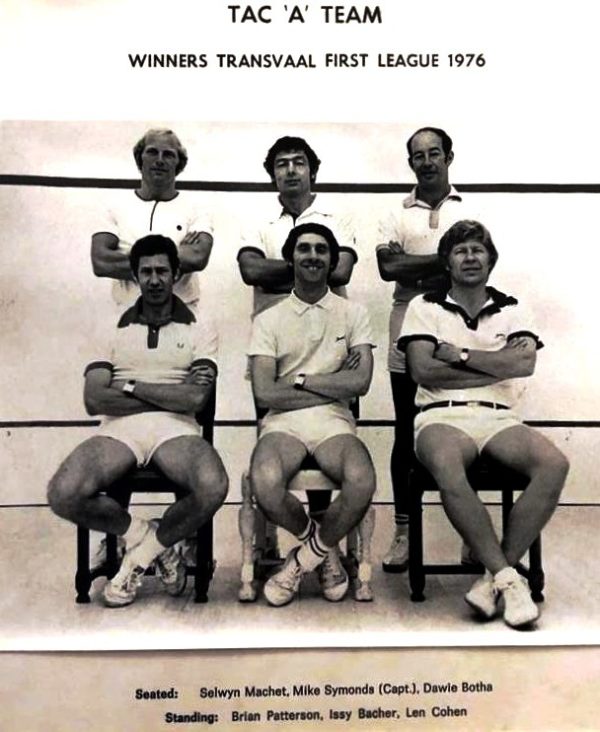
Around 1970, Len Cohen had the foresight to groom Selwyn Machet as the successor to Dawie Botha at the head of the TAC ladder. Machet, who would go on to win the SA Open in 1977 with victory in the final over Australian number 1 Dean Williams, and also earn his Springbok colours in the same year, was a young apprentice playing for the Norwood Municipal Club when Cohen approached him to play for the TAC. Machet credits Len Cohen, Natie Lieberman, Issy Bacher and other influential TAC members for sponsoring his membership of the club in those early years, which he gratefully acknowledges put him on the road to numerous tournament titles and to Springbok colours.
Tzody Aron chaired the club more than any other, first for three consecutive terms from 1979 to 1981 and then for 7 years from 1988 to 1994, with only one break in 1993 when he was relieved by M.S. Gluckman. Tzody realised that the key to the club’s success was the putting into action of the club’s thirteen league teams every week. He was the prime motivator of every league player who represented the TAC from the late seventies until well past the millennium, inspiring and managing the competitive spirit of the TAC across thirteen leagues. In so doing, he instilled in every league player, right down to the lowest league, a sense of pride and commitment in representing the TAC.
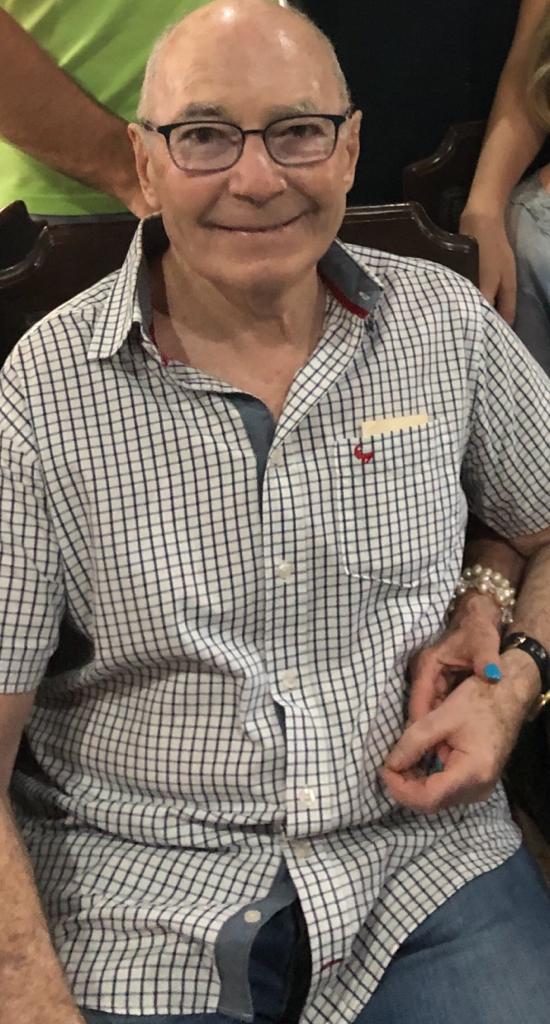
Tzody Aron
The sheer quality and intensity of this commitment paid off in the years 1980-1982, with the club winning the Transvaal First League and the coveted Banbury Trophy for the top team in league squash in all the provinces throughout South Africa for three consecutive years. This remarkable feat was rewarded with the club becoming the permanent holder of the Banbury Trophy, at the time the ultimate acknowledgement as the dominant force in South African squash.
Key to this success was the appointment of Mike Symonds, himself a member of the star-studded Banbury Trophy winning teams, as the club’s full-time coach. Symonds coached Banbury Trophy era stars Laurence Gruskin, Johnny Leeb and Denis Kampel and later groomed Mike Toothill and Jonty Aron as future stars. Testament to the quality of Symonds’ guidance was the achievement of Springbok colours by Gruskin and Toothill, the elevation of Leeb to a high of number three in South Africa, a national number seven ranking for Denis Kampel and the winning of the SA Under 19 Title by Jonty Aron.
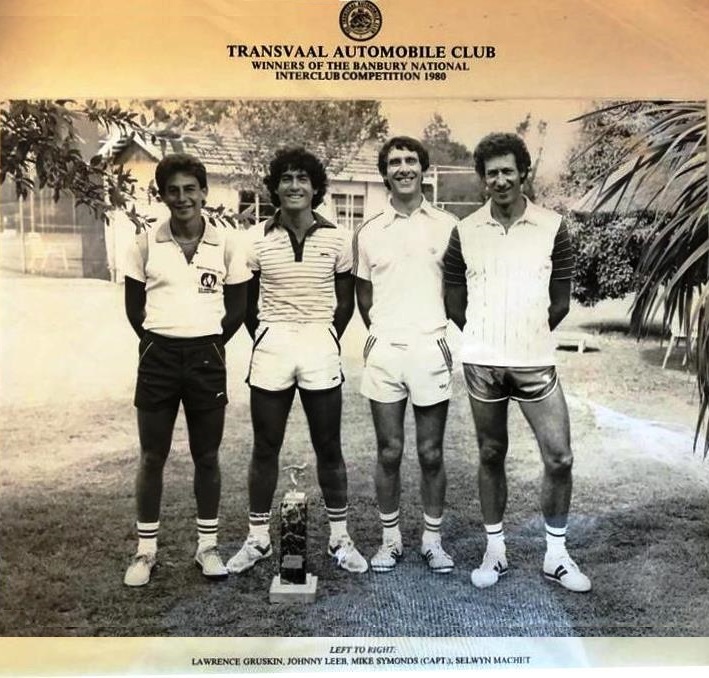
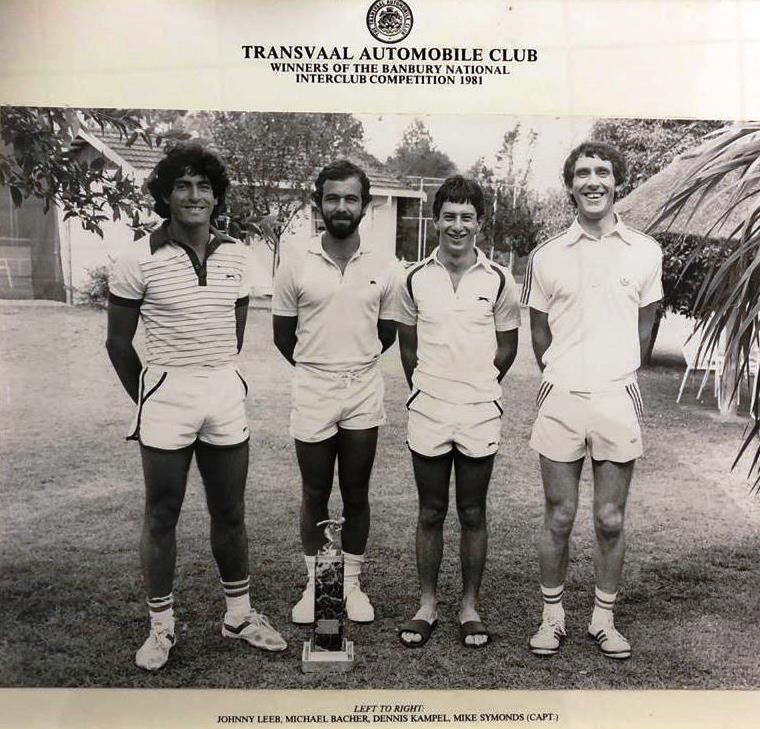
Besides Springbok Dawie Botha, who played for Northern Transvaal, Springboks Machet, Gruskin, Toothill, one time SA Number 3 Leeb and SA Number 7 Denis Kampel, who all got their provincial colours for Transvaal, the following players from the club also gained provincial colours (Transvaal unless otherwise stated): Issy Bacher, Len Weinstein, Clifford Sneider, Steven Nathan, Gary Bieber, Daniel Lederman, Martin Morris, Gary Zeller, Jonty Aron, Shayne Mann (Eastern Transvaal), Kevin Mann (Eastern Transvaal), Larry Pogir, Bokkie Lipschitz, Laurie Kampel, Martin Kampel, Michael Bacher, Gary Weinstein, Colin Blacher (Free State), Jonathan Brinkman, (Rabbi) Ryan Zail, Mark Kaplan, Sam Miltz, Warren Getz, Evan Flowers, Natie Lieberman, Len Cohen, Bruno Kampel, Jack Kampel and Mark Paiker (Northern Transvaal).
The club has also made an indelible contribution to the development of Squash in Israel. Selwyn Machet won the gold medal the first time squash was introduced at the Maccabi Games in 1977. Denis Kampel won gold at the 1985 and 1989 Games and the silver medal at the 1993 Games. There are a number of other club members, including Machet in later years, who have won medals in senior categories at the Maccabi Games.
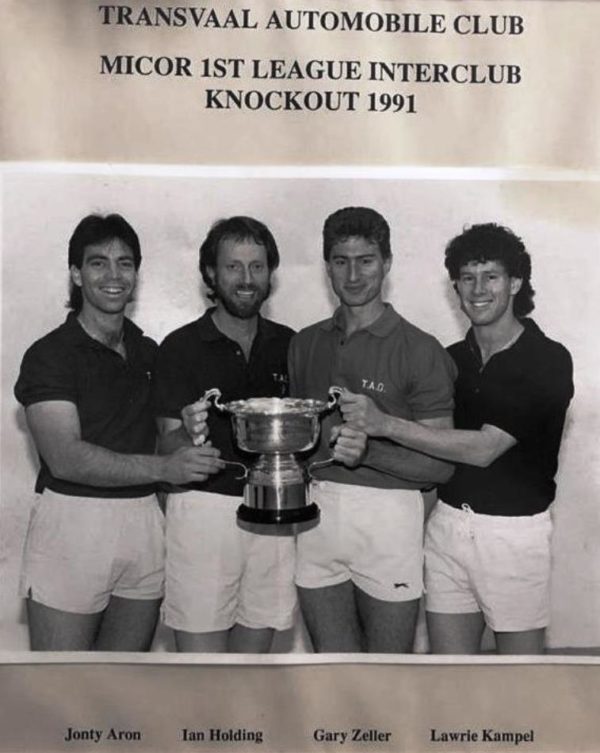
Another prominent member of the club, Glenn Lazarus, has made a profound contribution to the transformative prestige of the club through his involvement as program director of Egolisquash, a mass participation program for youth from less privileged communities. Participants in the program who have acquired coaching credentials conduct regular coaching sessions for youth from all communities at the club’s courts and at other venues.
Measured by its overall influence and impact on squash in South Africa, the TAC can have few peers in the way of Jewish sporting clubs, or clubs with a distinctly Jewish ethos, in Diaspora communities.
I conclude with three personal insights gleaned from writing this article. First, the competition for promotion on the TAC ladder was fiercely contested between club members. Although they were teammates for the weekly league encounters, in the intervening weeks they were opponents for promotion on the club ladder - vying for spots in higher league teams. Yet, in all my meetings with players and the one administrator, Tzody Aron, I was overcome by their camaraderie and enduring friendships. Second, all the parties I met felt a compelling need for the TAC story to be told and were prepared to give of their time and effort to facilitate the exercise. None of them, I must emphasise, was in pursuit of personal glory. They all simply knew the importance of preserving their enormous pride in the TAC. My third is more a note of despair – the squash section of the TAC is today a pale shadow of its former self. The once proudly displayed honours board and photographs have been removed. No more the incessant claps of shots ringing all around after work at peak. It saddens me, but helps me understand better the urgent clamour to record the memories of a golden past.
Sources
Interviews with Mark Paiker, Johnny Leeb, Selwyn Machet and Tzody Aron
City built on gold by L.E. Neame
The Golden City Johannesburg Compiled and Edited by Allister Macmillan
Johannesburg Street Names by Anna H Smith